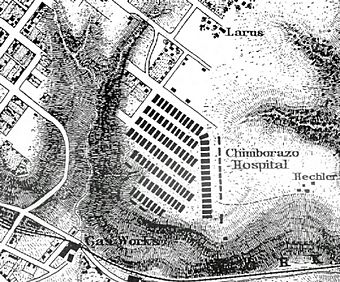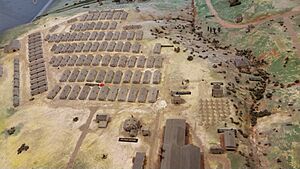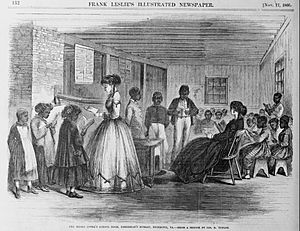Chimborazo Hospital facts for kids
Quick facts for kids |
|
|
Chimborazo Hospital
|
|
|
U.S. Historic district
Contributing property |
|

Inset of an 1865 map showing Chimborazo Hospital. To the south (bottom) are the tracks of the Richmond and York Railroad
|
|
| Location | Richmond, Virginia |
|---|---|
| Built | 1862 |
| Part of | Oakwood–Chimborazo Historic District (ID04001372) |
| Added to NRHP | March 18, 2005 |
Chimborazo Hospital was a very important hospital during the American Civil War. It was built in Richmond, Virginia, to help soldiers from the Confederate Army.
From 1862 to 1865, this hospital treated over 76,000 injured Confederate soldiers. It admitted almost 78,000 patients in total. Between 6,500 and 8,000 patients died there. This means that between 8.3% and 10.3% of patients passed away. This was one of the lowest death rates for military hospitals at that time.
After the war ended, the hospital buildings became a safe place for people who had been freed from slavery. Today, the area is known as Chimborazo Park.
Building a Giant Hospital
When the Civil War first began, most people thought it would end quickly. Because of this, the Confederate government didn't set up many important things, like proper hospitals. Many sick or injured soldiers were sent to regular homes for care. This often led to poor treatment and even made the caretakers sick.
Most hospitals in Richmond were not built for medical use. They were old warehouses, hotels, or stores that were turned into hospitals. These places quickly became too crowded. So, Samuel P. Moore, the main doctor for the Confederacy, needed to find new places for hospitals fast.
Around the same time, on a hill in eastern Richmond called Chimborazo Hill, enslaved people were already building winter homes for soldiers. These included barracks, officer housing, three hospitals, and a bakery. Since most Confederate soldiers would be further north for the winter, Dr. Moore decided to turn these barracks into a huge hospital. He put Dr. James B. McCaw, a professor from the Medical College of Virginia, in charge.
The hospital's name, Chimborazo, is thought to come from a large volcano in Ecuador with the same name.
Life Inside the Hospital
Chimborazo Hospital was very organized, and they kept excellent records. It had ninety hospital wards, which are like separate buildings for patients. Each ward had a shingled roof, wooden floors, and walls painted white inside and out. Every building had three doors and ten windows, each with a white curtain. A wood stove kept each ward warm, and a single candle provided light at night.
Each ward was about eighty feet long and twenty feet wide. It could hold around forty beds. Besides the patient wards, there were many other buildings. These included bakeries, kitchens, ice houses, a place to make soap, a stable, a guard house, a chapel, and a bathhouse. There were also shops for carpenters, blacksmiths, and pharmacists, plus five "dead houses" for those who passed away. Dr. McCaw believed fresh air was important for healing, so wide paths separated all the buildings.
Dr. McCaw created a strict system for how the hospital was run. There were different divisions, each with surgeons, assistant surgeons, nurses, cooks, and other staff. All surgeons had to have at least five years of medical experience. Other jobs were done by soldiers, free Black people, enslaved people, and white women.
For most of the war, the hospital had enough food and good medical care. Even when many wounded soldiers arrived from battles like the Seven Days Battles, they managed to set up tents for everyone. However, like all hospitals back then, resources sometimes ran low. This could lead to less-than-perfect care and unclean conditions. Soldiers who died at Chimborazo were buried at Oakwood Cemetery.
A New Purpose After the War
When news came that Confederate General Robert E. Lee was retreating on April 2, 1865, patients started to leave or were moved out. Dr. McCaw officially gave up control of the hospital the next day. Some Confederate wounded stayed as Union soldiers began bringing their own injured to the hospital. Union and Confederate soldiers were kept in separate wards. By early summer, all patients had left.
Soon after the military left, people who had been freed from slavery began to live at the site. The 13th Amendment had ended slavery, but it didn't give freed people jobs, land, or homes. The Freedmen's Bureau was set up to help with these needs. However, it faced many challenges, including not having enough resources and dealing with laws that limited the rights of Black people. The freed people living at Chimborazo were often kept separate from the rest of society.
The Chimborazo refugee camp became a big problem for the city of Richmond. White neighbors often complained about the camp and sometimes even caused riots. Since Chimborazo was just outside the city limits, the people living there had little protection. This led them to form their own group to keep safe. Richmond later expanded its city limits to include Chimborazo.
In March 1866, there were serious violent events. Local news first said that Black people were attacking white people. But it was later found that white men had been bothering and threatening the community. Several arrests were made, though most of those arrested were later released.
Because of these problems, the Freedmen's Bureau told all able-bodied men to leave the camp by April 1, 1866. They expected only about 150 people to remain out of the 1,000 living there. However, by 1870, records show that 651 Black voters lived in the area that included Chimborazo. Since women and children weren't counted, the actual number of residents was likely much higher.
Over time, the City of Richmond bought the land where Chimborazo Hospital once stood. They gradually removed all the old buildings and started creating Chimborazo Park.
Today, Chimborazo Park is partly owned by the City of Richmond and partly by the U.S. government. The park has several monuments, including a smaller version of the Statue of Liberty. There's also a museum and visitor center, which is the main office for Richmond National Battlefield Park. This museum mostly focuses on how doctors treated soldiers during the Civil War. The neighborhood around the park is now a nationally recognized historic district.
Learn More
- Richmond National Battlefield Park
- Oakwood Cemetery (Richmond, Virginia)





